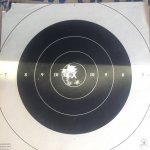I am experiencing difficulty, or at least more than normal seating pressure when seating bullets in "squeaky" clean brass. I should add, I am using type s bushnig dies and am using a bushing to achieve .001-.0015" neck tension. I would say when I first started reloading I was probably making more consistent and accurate ammo as opposed to now and I think it has come down to how I am cleaning my brass. After some frustration, I bought a tumbler (like I used to use) with walnut media and processed some brass -- bullets seated like butter. I then tried some SS cleaned brass and bullets once again seated tough.
I understand the reason for all of this, but never paid too much attention to how it was affecting my accuracy. It is! Bullets seated in media processed brass showed to be much more accurate (group wise) with now vertical stringing. SS media process brass with tough seating all had at least two vertical flyers out of five shot groups. Now, with SS cleaned brass, I tried using some imperial dry lube on the inside of the necks before seating bullets and this helped -- it also showed on paper.
I thought I'd share my experiences and would like to see if others have had similar results. I may go back to the old fashioned tumbler method from now on, or lube my case necks before bullet seating.
I understand the reason for all of this, but never paid too much attention to how it was affecting my accuracy. It is! Bullets seated in media processed brass showed to be much more accurate (group wise) with now vertical stringing. SS media process brass with tough seating all had at least two vertical flyers out of five shot groups. Now, with SS cleaned brass, I tried using some imperial dry lube on the inside of the necks before seating bullets and this helped -- it also showed on paper.
I thought I'd share my experiences and would like to see if others have had similar results. I may go back to the old fashioned tumbler method from now on, or lube my case necks before bullet seating.


